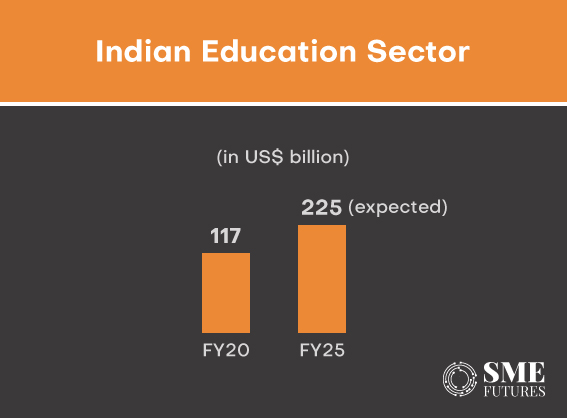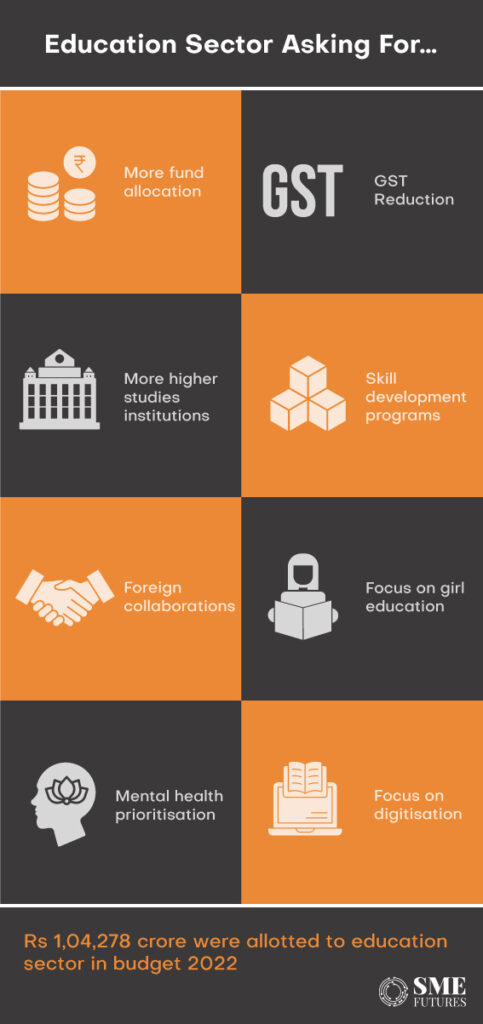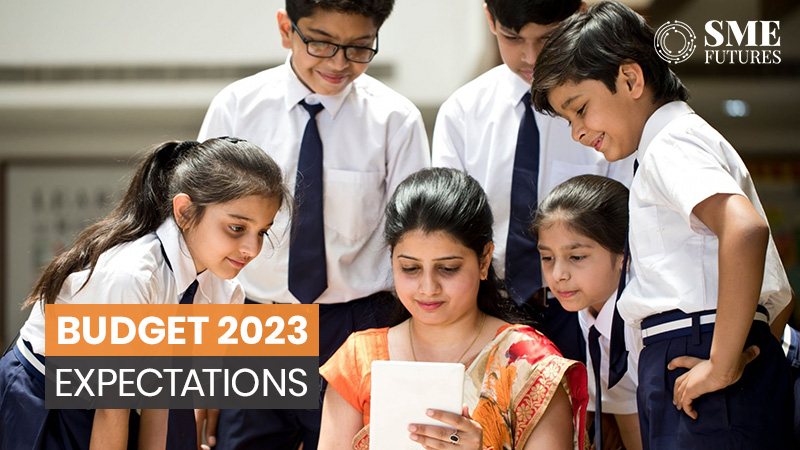One needs to educate themselves on any career route, whether it be in business, politics, or another field, if one wants to succeed or advance in life.
Similarly, every citizen’s right to an education is a critical step in a nation’s development. Hence, the Indian education sector plays an important role in making it a 5 trillion economy and becoming a developed country by 2047.
According to the data, the education sector in India was estimated to be worth 1US$ 117 billion in FY20 and is expected to reach US$ 225 billion by FY25. While the Edtech market size is expected to reach US$ 30 billion by 2031, from US$ 700-800 million in 2021.

Now, to reach these estimations, the education sector has all its eyes on the upcoming union budget 2023. Although the sector is swiftly growing post-pandemic, it feels like insufficiency in funds allocated.
As in last year’s budget, the education sector was only 2.6 per cent of the total funding, with Rs 40,828 crore set aside for higher education, while a fund of Rs 63,449 was granted for school education.
Here are some much-anticipated initiatives, that stakeholders from the education sector are hoping the government to take.
Increasing the budget allocation
Proper utilisation of allocations this year would mark the beginning of changes mentioned in the NEP 2020. This could include providing free or subsidized tuition, upgrading school infrastructure, setting up scholarships & grants & involving technology-based learning.
Also Read: Economic Survey 2023: Indian economy to grow 6.5% next fiscal year
Talking of the shortage of funds, the Chairperson of Dharav High School and Pro- Vice Chairperson of DPS International Gurugram, Devyani Jaipuriya says, “We are expecting the upcoming Budget to be exemplary and give the education sector a breather from the ongoing fund crunch.”
“Increasing the GDP spend from 1.7 per cent to 6 per cent will help in opening more opportunities and bring education for everyone regime closer to success,” she added.
Demanding the same, “For higher education, the government should allocate funds to promote research, the establishment of the National Research Foundation that can fund research in both govt and private institutions, with investment in the faculty development and National Mentoring Programme as envisaged under the NEP,” said Siddharth Chaturvedi, Director at AISECT.
He further added, “The government should also focus on creating dedicated funds for Edtech startups/ initiatives to promote regional language content for learners from tier-2 and tier-3 markets.”
Weighing in, the Chairperson of SAI International Education Group, Dr Silpi Sahoo says, “We can expect an elaborate focus & allotment towards revised learning methods like situated learning environment, vocation/internship, and incentives for employers to invest in talent pipelines.”
GST reduction
A robust framework to lower the cost of higher education while also granting applicants with higher rebates and deductions in tax calculations shall make upskilling a mainstream phenomenon.
“The GST on educational services should be reduced from 18 to 5 per cent. Removing GST in upskilling programs to make it easier for students to pursue higher education, such as scholarships and loan schemes,” Shaoo expressed.
Also Read: Budget wishlist: Economy can touch $5 tn if lives of farmers improve
Highlighting the same for Edtech startups, Founder & CEO of StockDaddy, Alok Kumar says, “With other tax relief and incentives, Edtech startups would be expecting a lower tax slab on educational products and services. A 5 per cent tax would provide a boost as a high tax slab acts as a barrier to their sustainability and growth.”
Skill development programs
At this point, it is critical to strengthen India’s digital infrastructure for higher education and skilling. “In this budget, I hope the government gives further emphasis to skilling and upskilling programmes that enable learners to master in-demand, industry-ready skills like AI, cloud and cyber so that the young workforce will have the skills to lead the economy forward,” mentioned Chaturvedi from AISECT.
According to experts, more importance has to be on vocational training to create a talent pool of skilled workers and to bridge the gap that exists in the system.
“The government should focus on funding more programmes that empower women by providing skills training in Digital Productivity, Communication Skills, Employability Skills, and Entrepreneurship Skills,” he added.
“Long-term welfare policies like skill-centric learning should be enacted to increase pupils’ learning possibilities. Also, a major focus should be made on shifting learning pedagogy from theory to practice where students can experience real-life projects for the duration of courses which helps them to become independent,” says Tanvi Miglani, Spokesperson of HLM Group of Institutions.

Digitisation in education
The government announced the opening of the digital university and expanded the ambit of the PM e-vidya programme in the last budget. This year, “the budget should bring more reforms to expedite the digital learning revolution, which will help create a parallel education mechanism and give many students quality-based learning,” said Divya Jain, Director of The Class of One.
Weighing in, Jaipuriya of DPS says, “We are hoping the Union Budget will announce developmental plans for areas like digitisation, internationalization of higher education, investment in skill development, and emphasis on regional languages in technical and medical education, among others.”
Focus on girl child education
Even in the year 2022, the percentage of girls within the age group of 11 to 16 years, enrolled in urban schools remains at a stooping 23.5 per cent. “The budget should have a stipulated allocation towards policies to promote a larger percentage of girl education, in the form of scholarships & tax exemptions & more to achieve the gender-based targets as set by NEP 2020,” says Sahoo from IAS International.
Also Read: Union Budget 2023: Indian auto industry pins hope on government to rev up e-vehicle market
Miglani from HLM Group of Institutions, “Government should emphasise special schemes or reserve funds for girls’ education.”
Higher studies institutions
Good B-Schools generally receive not less than 5,000 applications against say 240 seat availability, implying a demand of more than 20 times the available supply. With such supply, the higher education market is certainly a sellers’ market. Indian B-schools keep cribbing about the quality of students they get.
To tackle that, Dr V.P. Singh, Professor of Economics, at the Great Lakes Institute of Management, suggested that “the government has to increase the Gross Enrolment Ratio in higher education to 50 per cent by 2035. That is why it is giving approvals of higher intake in both offline as well as online courses.”
He asked, “Are Indian institutions ready to absorb this demand? The government does not feel so and that’s why it is letting foreign universities open their centres in India. Instead of waiting for the government to do something it is time that the private sector gears for capturing the huge demand.”
Focus on mental health
With transcending academic pressure & increased screen time with almost every approaching year, it is important to bring rules and focus on the mental well-being of students.
Suggesting the same, Sahoo said, “The govt should consider allocating some section of funds for wellness schemes and programs by qualified professionals to provide students with apt guidance and support. It will act as a valuable resource to help students learn coping strategies and build resilience, thereby creating a conducive environment for learning.”
“After Covid, the government should adopt a caring approach and create policies that support pro-mental health policy positions for students, Miglani added.
Weighing in, Anshu Mital, Principal of MRG School Rohini, said, “There is also a need to strategise policies to activate mental health professionals and psychologists to help distressed students and normalise mental health issues and create an open-ended dialogue space for them.”
Foreign collaborations
Facilitating formal partnerships with eminent universities abroad to offer online and hybrid degree programs to achieve the Gross Enrolment Ratio targets set by the government is relevant to consider this year.
On the contrary, “keeping in view the government’s initiative of inviting foreign universities to the country, they must also focus on improving the state of the private universities in India,” says Miglani.
Overall, there a lot of many suggestions and hopes that the education sector is relying, on the budget 2023-24. Allocation of more funds is at the top of their expectations for now.











